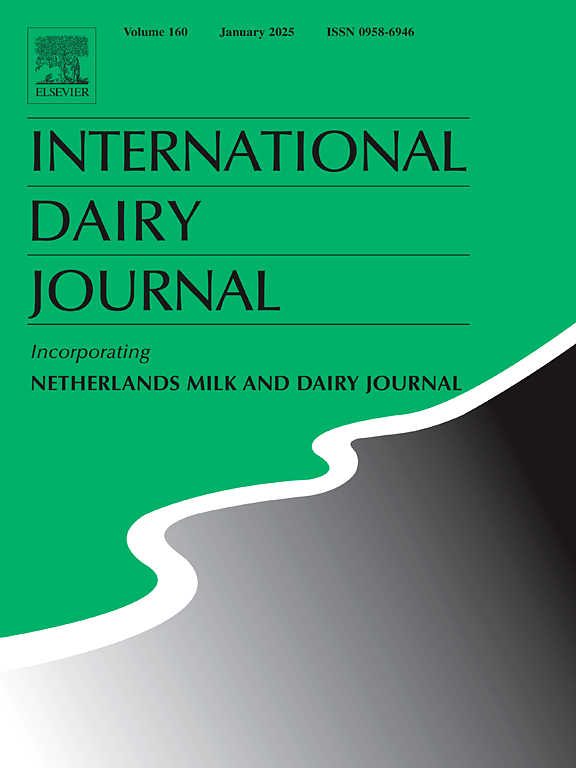Influence of the ratio of fresh cream to anhydrous milk fat on the quality and flavor of recombined protein-based emulsions
IF 3.1
3区 农林科学
Q2 FOOD SCIENCE & TECHNOLOGY
引用次数: 0
Abstract
A novel recombined protein-based emulsions was developed by combining anhydrous milk fat with fresh cream to enhance the stability and application properties of whipped cream. The study investigated the effect of different anhydrous milk fat (AMF) ratios (0 %, 20 %, 40 %, 60 %, 80 % and 100 %) on the stability, whipping properties, microstructure and flavour of the recombined whipped cream. Viscosity, particle size, stability, zeta potential and flavour of static emulsions were measured and foam hardness, overrun, fat partial coalescence and microstructure of aerated protein-based emulsions were analyzed. The results demonstrated that the ratio of 20∼40 % AMF enhanced the stability, foam hardness, viscosity and average particle size of whipped cream. When the ratio of AMF was 20∼40 %, the emulsion had the best stability, the highest absolute value of zeta potential (30.5–30.8 mV), higher foam hardness (1280.89–1369.19 g), higher overrun (172.4–174.7 %), shorter whipping time (211–217 s) and lower degree of fat partial coalescence (6.1–8.4 %). The moulding performance was well, the plasticity was strong, and the microstructure was observed to have uniform air bubble size. In addition, the flavour improves on the base of whipped cream made from AMF. Overall, the quality characteristics of whipped cream were found to be superior when 20–40 % AMF was incorporated into the protein-based emulsions.
新鲜奶油与无水乳脂的比例对重组蛋白乳剂的质量和风味的影响
为了提高鲜奶油的稳定性和应用性能,将无水乳脂与鲜奶油结合,研制了一种新型复合蛋白乳剂。研究了不同比例的无水乳脂(AMF)(0%、20%、40%、60%、80%和100%)对复合鲜奶油的稳定性、搅打性能、微观结构和风味的影响。测定了静态乳状液的粘度、粒径、稳定性、zeta电位和风味,分析了充气蛋白基乳状液的泡沫硬度、溢出、脂肪部分聚结和微观结构。结果表明,20 ~ 40%的AMF添加量提高了鲜奶油的稳定性、泡沫硬度、粘度和平均粒径。当AMF添加量为20 ~ 40%时,乳液稳定性最佳,zeta电位绝对值最高(30.5 ~ 30.8 mV),泡沫硬度高(1280.89 ~ 1369.19 g),超限高(172.4 ~ 174.7%),搅拌时间短(211 ~ 217 s),脂肪部分聚结度低(6.1 ~ 8.4%)。成型性能好,塑性强,微观组织气泡尺寸均匀。此外,在AMF制成的鲜奶油的基础上,味道得到改善。总的来说,当20 - 40%的AMF加入到蛋白基乳剂中时,鲜奶油的质量特性是优越的。
本文章由计算机程序翻译,如有差异,请以英文原文为准。
求助全文
约1分钟内获得全文
求助全文
来源期刊

International Dairy Journal
工程技术-食品科技
CiteScore
6.50
自引率
9.70%
发文量
200
审稿时长
49 days
期刊介绍:
The International Dairy Journal publishes significant advancements in dairy science and technology in the form of research articles and critical reviews that are of relevance to the broader international dairy community. Within this scope, research on the science and technology of milk and dairy products and the nutritional and health aspects of dairy foods are included; the journal pays particular attention to applied research and its interface with the dairy industry.
The journal''s coverage includes the following, where directly applicable to dairy science and technology:
• Chemistry and physico-chemical properties of milk constituents
• Microbiology, food safety, enzymology, biotechnology
• Processing and engineering
• Emulsion science, food structure, and texture
• Raw material quality and effect on relevant products
• Flavour and off-flavour development
• Technological functionality and applications of dairy ingredients
• Sensory and consumer sciences
• Nutrition and substantiation of human health implications of milk components or dairy products
International Dairy Journal does not publish papers related to milk production, animal health and other aspects of on-farm milk production unless there is a clear relationship to dairy technology, human health or final product quality.
 求助内容:
求助内容: 应助结果提醒方式:
应助结果提醒方式:


